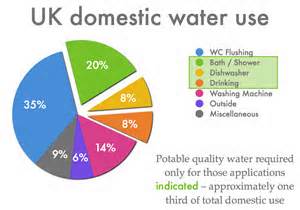Domestic water demand management – it is attainable and affordable
Process Industry Forum asked David Lloyd Owen to comment on his views on whether domestic water demand management is it attainable and affordable?
Living within our limited water means
Can south and eastern England live within its water resources? Faced with the triple crunch of population growth (from 22.1 million in 2010 to 25.9 million by 2030), climate change (hotter, drier summers and winters with the wrong sort of rain) and the Water Framework Directive (river flows to be maintained or indeed, restored) there has been much talk about new reservoirs, desalination plants and water transfers from wetter parts of Britain. Perhaps instead it is time to consider using what assets we have in a more effective way. This Perspective considers how domestic demand management can benefit the regions’ water resources.
Demand management is especially pertinent when you realise that Britain’s driest regions are also their most profligate domestic water consumers:
Domestic water consumption, 2008-09 (l/c/d)
| EA Region | Unmetered | Metered | Total | Difference |
| Anglian | 158 | 139 | 147 | 12% |
| Southern | 149 | 137 | 145 | 8% |
| Thames | 163 | 142 | 158 | 13% |
| England & Wales | 150 | 127 | 143 | 15% |
Water demand management is about assisting us to live within our water limits by encouraging usage that fits available resources. It is also about ensuring that only the assets we need are developed and deployed, rather than further systems for dealing with avoidable peaks in water demand.

A low priority in practice
Currently, demand management isn’t taken terribly seriously. Many will hotly deny this, but the Environment Agency has an official target of 130 l/c/day by 2030 and two positive water use scenarios for 2050; ‘innovation’ at 125 l/c/day and ‘sustainable’ at 110 l/c/day. Meanwhile, the former Tendring Hundreds Water in Essex (now part of Affinity Water) shows how unambitious these targets are. For its metered customers (75% in 2012) average consumption in 2010-11 was 111 l/c/day and for the unmetered customers, 125 l/c/day. Why? Public education and advice allied with targeted tariff schemes. Demand management, here and now.
Current Building Regulations hint that more can be done; all new builds should use less than 125 l/c/day, along with three more stringent levels (80, 100 and 120 l/c/day) for outputs such as social housing. But new builds don’t touch our extant housing stock, which we tend to hold onto; only 15% of Britain’s households live somewhere built since 1990. Today, even basic measures such as metering remain mired in political and regulatory delays.
Does demand management matter?
Meters and other measures cost money, and so do the other,asset based alternatives. The overall bill will be lower, as new assets such as the proposed £11billion North-South water transfer project would not be needed. On a comparable basis, Malta’s comprehensive smart water and electricity metering and smart grid programme would cost approximately £3.1 billion.
Smarter thinking about our water
We need to fundamentally reassess the way we use water, especially through the new tools offered by ‘smart’ water. Demand management is about opening up two way communications between the utility and the consumer, allowing the consumer to make informed decisions about their water usage and to beneficially change their usage.
For example, if water availability is better during a wet winter than a dry summer, tariffs should encourage water conservation when availability is at its lowest. Likewise, there are daily usage spikes which can be smoothed out by having lower night-time tariffs so people use dish and clothes washers when demand is at its lowest. This principle has been used for electricity supplies for decades.
Since people tend to be more aware about their electricity bills, why not link the two? This is not an impossible demand. We appreciate what constitutes good value when doing our household shopping and are increasingly aware of the need to eke the best value out of our energy bills. 30-50% of household electricity bills typically involve heating water, so when a consumer knows the difference in both electricity and water costs between having a bath and a shower, opting for the latter becomes more compelling. Is this utopian? Not in parts of the USA and Malta.
Rethinking regulation
Regulation needs to evolve to enable this. Utilities can be regulated on an innovation and efficiency based formula, which is related to minimising overall water use within consumption caps.
White goods and grey water
Great strides are being made in water efficient white goods such as low and minimal water washing systems and lavatories. Smart systems would inform you about each units annual water cost both in water and power. Greywater recovery ought to be the norm in apartment blocks and the same applies to rainwater harvesting. These need to be the norm for new builds and encouraged in more traditional houses through tariffs.
Smart metering can make tariffs fairer
I suspect that even smart water evangelists have not yet fully grasped its potential. For example, a fully informed utility could know how many people there are in each household and what their economic circumstances are. Armed with this, progressive tariffs could be used without compromising affordability. Instead of a rising bock tariff (the more you use, the more you pay per unit of water over a certain point) on a per household basis, it could be charged per capita, no longer penalising families and so on. Likewise, low income households could be automatically be billed at a social tariff rate.
More from less

To prevent future droughts, we have to consume less water in 2030 than we do today. Indeed, consumption needs to fall further to meet the climate change and water framework challenges.
Current domestic water consumption and consumption in 2030 by usage (l/c/day)
| Usage (mega litres per day) | Current | 2030 | 2030 | 2030 |
| Consumption | No change | 130 | 100 | |
| Anglian | 857 | 1,025 | 906 | 697 |
| Southern | 1,234 | 1,430 | 1,282 | 986 |
| Thames | 1,232 | 1,427 | 1,174 | 903 |
| South & eastern England | 3,322 | 3,881 | 3,362 | 2,586 |
The 130 l/c/day target fails to provide such resilience. As the table above suggests, demand management needs to be deployed to push overall demand closer to 100 l/c/day, something which I believe is reasonable, equitable and achievable. How can we achieve it? Smart metering, where water and power usage and costs are interlinked is the simplest tool, especially when this is combined with squeezing more use out of every litre of water that our domestic appliances use. It is about putting the little things together for a greater goal; when the single flush loo becomes a folk memory, that alone will go a long way to making our households truly water efficient.
Get the latest process industry news
Interested in receiving even more industry-leading news from Process Industry Forum delivered directly to your inbox? Then sign up to our free newsletter. Bringing you the latest news, trends, innovations and opinion from across the process industry, our exclusive newsletter gives you all the industry insights of the moment in one, easy-to-digest bulletin. Stay ahead of the competition with regular process industry news instalments from PIF.
